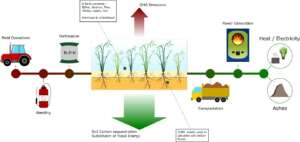Optimized selection of Salix variants for bioenergy – A life cycle perspective
Background
Energy generation using sustainable biomass can be a viable climate mitigation strategy, as it can replace fossil fuels for heat and electricity generation. Short rotation coppice plantations of Salix spp. (willows) have the potential to provide fast-growing biomass with significant soil and climate-mitigation benefits. This has generated interest in Salix plantations in several countries as a source of sustainable biomass feedstock.
Several varieties of Salix have been developed, and they display significant variations in their physiological traits, productivity, growth patterns and effects on soil. However, how these differences influence the overall Salix-powered bioenergy system and its impacts on the climate have rarely been studied, especially from a systems perspective.
Aims
The aim is to investigate how the genotypic differences between Salix variants influences the energy performance and climate impacts from utilizing Salix biomass as a feedstock for bioenergy systems for production of heat and electricity.
The intention is to provide a basis for comparison of different varieties which would help in selection of the optimal Salix varieties to balance power output and climate impacts from a bioenergy system.
Approaches
Life cycle analysis methodology is used to quantify the effects of Salix variety on the climate-impact and energy performance. Energy and material flows and emissions of greenhouse gases (GHGs) associated with the total production chain of the Salix-based bioenergy system are to be analyzed – starting from cultivation till production of power. Climate impacts will be calculated using a time-dynamic metric which takes into account the timing of GHGs, as conventional global warming potential metric does not capture the effect of timing of emissions or sequestrations.
The flow of carbon from the growing plants to the soil and its decomposition will be modelled using the soil carbon model ICBM. This will present a picture of how much carbon can be potentially added or removed from the soil as a result of the cultivation of the different Salix varieties. Data collected from a Swedish field trial involving six commercial Salix varieties during the period 2001-2018 are used for the analysis.
Keywords
Climate impact, Bioenergy, Biomass production, Life Cycle Assessment (LCA), Soil organic carbon, Power generation, Short-rotation coppice willow
Project leaders
Per-Anders Hansson, Department of Energy and Technology, SLU
Ann-Christin Rönnberg Wästljung, Department of Plant Biology, SLU
Other project members
Saurav Kalita, Åke Nordberg, Mats Sandgren, Martin Weih and others, SLU
Other funding agencies
Our research in this area is co-funded mainly from Formas

